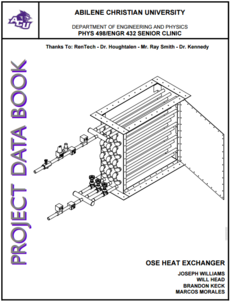ACU Heat Exchanger Project: Difference between revisions
No edit summary |
No edit summary |
||
| Line 5: | Line 5: | ||
==Performance Requirements== | ==Performance Requirements== | ||
*2.5'x2.5'x1' | |||
*50,000+ BTU heat source | *50,000+ BTU heat source | ||
*2 GPM output water flow-rate | *2 GPM output water flow-rate | ||
| Line 15: | Line 16: | ||
{{YoutubePopup|R35NzgQ7QIc|big}} | {{YoutubePopup|R35NzgQ7QIc|big}} | ||
===AutoCAD Drawings File=== | ===AutoCAD Drawings File=== | ||
The AutoCAD Drawings File details the individual pieces to the assembly as well as the dimensions and final product. | |||
[[File:Detail Drawings 11.pdf]] | [[File:Detail Drawings 11.pdf]] | ||
==Manufacturing Plan== | ==Manufacturing Plan== | ||
==Testing== | ==Testing== | ||
==Conclusion== | ==Conclusion== | ||
===Lessons Learned=== | |||
*Making better assumption during the calculations that led to the design | |||
*Finding a better "do-it-yourself" approach to cutting the holes by which the pipes ran through | |||
*Finding an easier direction to forming the pipe headers | |||
*Using a heat source with a slower air flow-rate for better heat transfer results | |||
===Improvements=== | |||
Latest revision as of 05:51, 13 May 2016
Document the heat exchanger here according to Instructions.
Open Source Ecology, an "open source economy" created with the goal of innovating efficient tools for practical use. This project had the goal of using a heat exchanger consisting of pipe-and-fittings design to achieve the specifications unique to this project yet generalized enough to have a global impact.
Performance Requirements
- 2.5'x2.5'x1'
- 50,000+ BTU heat source
- 2 GPM output water flow-rate
- System Pressure at a minimum of 30 PSI
- 140 degrees Fahrenheit output water temperature
Drawings
SketchUp Video
There was board insulation placed around the outside walls of the heat exchanger to increase heat transferred to the water. Additionally, the temperature gauge and pressure gauge were used for the purposes of testing the design and not intended for the final product. Open Source Ecology compatibility was necessary to ensure the product could be integrated into the global village construction set and door for easy cleaning.
http://img.youtube.com/vi/R35NzgQ7QIc/0.jpg
AutoCAD Drawings File
The AutoCAD Drawings File details the individual pieces to the assembly as well as the dimensions and final product.
Manufacturing Plan
Testing
Conclusion
Lessons Learned
- Making better assumption during the calculations that led to the design
- Finding a better "do-it-yourself" approach to cutting the holes by which the pipes ran through
- Finding an easier direction to forming the pipe headers
- Using a heat source with a slower air flow-rate for better heat transfer results
